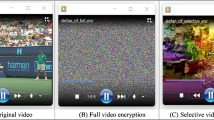Abstract
Chaotic cryptography has been applied to image encryption; however, only the traditional low-dimensional chaotic systems has been widely analyzed or deciphered, which does not show satisfied security and efficiency. To solve this problem, a new algorithm based on cross-chaos map has been created in this article. The image pixels are scrambled under control of high-dimensional chaotic sequence, which is generated by cross chaotic map. The image pixels are substituted by ciphertext feedback algorithm. It can relate encryption required parameters with plaintext and can make a plaintext byte affect more ciphertext bytes. Proved by theoretical analysis and experimental results, the algorithm has higher complex degree and has passed SP800-22 pseudo-random number standard tests, and it has high encryption speed, high security, etc. It can be widely applied in the field of image encryption.
Similar content being viewed by others
References
Wang Xingyuan. Chaos in the Complex Nonlinear Systems [M]. Beijing: Publishing House of Electronics Industry, 2003 (Ch).
Palmaore J. Computer Arithmetic, Chaos and Fractals [J]. Physica, 2006, 42: 99–110.
Jakimoski G, Kocarev L. Analysis of some recently proposed chaos-based encryption algorithms [J]. Physics Letters A, 2001, 291(6): 381–384.
Zhang L H, Zhang Y F. Research on Lorenz chaotic stream cipher [C]//VLSI Design and Video Technology 2005 Proceedings of IEEE International workshop. New York: IEEE Press, 2005: 431–434.
Wang Lei. Research of one-way hash function based on Logistic map [J]. Computer Engineering and Design, 2006, 27(5): 774–776 (Ch).
Wang Yong, Wong K W, Liao Xiaofeng, et al. A new chaos-based fast image encryption [J]. Software Applications, 2011, 11(1): 514–522.
Xiao D, Liao X F, Wei P C. Analysis and improvement of a chaos-based image encryption algorithm [J]. Chaos, Solitons & Fractals, 2009, 40(5): 2191–2199.
Wang Y, Liao X F, Xiang T. Cryptanalysis and improvement on a block cryptosystem based on iteration a chaotic map [J]. Physics Letters A, 2007, 363: 277–281.
Alvarez E, Femandez, Gacria P, et al. New Approach to Chaotic Encryption [J]. Physics Letters A, 1999, 263(4–6): 373–375.
Bpatista M S. Cryptography with chaos [J]. Physics Letter A, 1998, 240(l–2): 50–54.
Wang Y F, Shen H B, Yan X L. Output cryptograph mixed feedback chaos stream cipher design [J]. Journal of Zhejiang University, 2006, 11(40): 31–37.
Liu Jialing, Zhang Hong, Wang Yong. Analysis and improvement on a class of iterative chaotic block cipher [J]. Computer science, 2008, 16(135): 141–144 (Ch).
Klapper A. The vulnerability of geometric sequences based on fields of odd characteristic [J]. Journal of Cryptology, 1994, 7: 33–52.
Wong W K, Lee L P, Wong K W. An improved chaotic encryption method [J]. Computer Physics Communications, 2001, 138(3): 234–236.
Ren Hong’e, Shang Zhenwei, Zhang Jian. Image encryption algorithm based on new two-dimensional map for rectangular image [J]. Optical and Precision Engineering, 2008, 16(8): 1483–1489 (Ch).
Zhang Q, Guo L, Wei X P. Image encryption using DNA addition combining with chaotic maps [J]. Mathematical and Computer Modelling, 2010, 52: 2028–2035.
Liao X F, Lai S Y, Zhou Q. A novel image encryption algorithm based on self-adaptive wave transmission [J]. Signal Processing, 2010, 90: 2714–2722.
Han Fengying, Zhu Congxu. One kind based on double unidimensional chaos system picture encryption algorithm [J]. J Computer Engineering and Applications, 2007, 43(20): 50–51.
Lu Kan, Sun Jianjun, Huang Youlai, et al. Chaotic Dynamics [M]. Shanghai: Shanghai Translation Press, 1990(Ch).
Geisel T, Fairen V. Statistical properties of chaos in Chebyshev maps [J]. Physics Letters A, 1984, 105: 263–266.
NIST. SP800-22-1. A Statistical Test Suite for Random and Pseudorandom Number Generators for Cryptographic Applications [S]. Gaithersburg: NIST, 2001.
Author information
Authors and Affiliations
Corresponding author
Additional information
Foundation item: Supported by the National Natural Science Foundation of China (60973162), the Natural Science Foundation of Shandong Province of China (ZR2009GM037), the Science and Technology Project of Shandong Province, China (2010GGX10132, 2012GGX10110), the Key Natural Science Foundation of Shandong Province of China (Z2006G01), and the Soft Science Project of Shangdong Province of China (2012RKA10009)
Biography: TONG Xiaojun, female, Professor, research direction: chaos cryptography and information security.
Rights and permissions
About this article
Cite this article
Tong, X., Liu, Y., Zhang, M. et al. New chaotic image encryption algorithm based on cross-mapping. Wuhan Univ. J. Nat. Sci. 17, 461–467 (2012). https://doi.org/10.1007/s11859-012-0871-y
Received:
Published:
Issue Date:
DOI: https://doi.org/10.1007/s11859-012-0871-y




